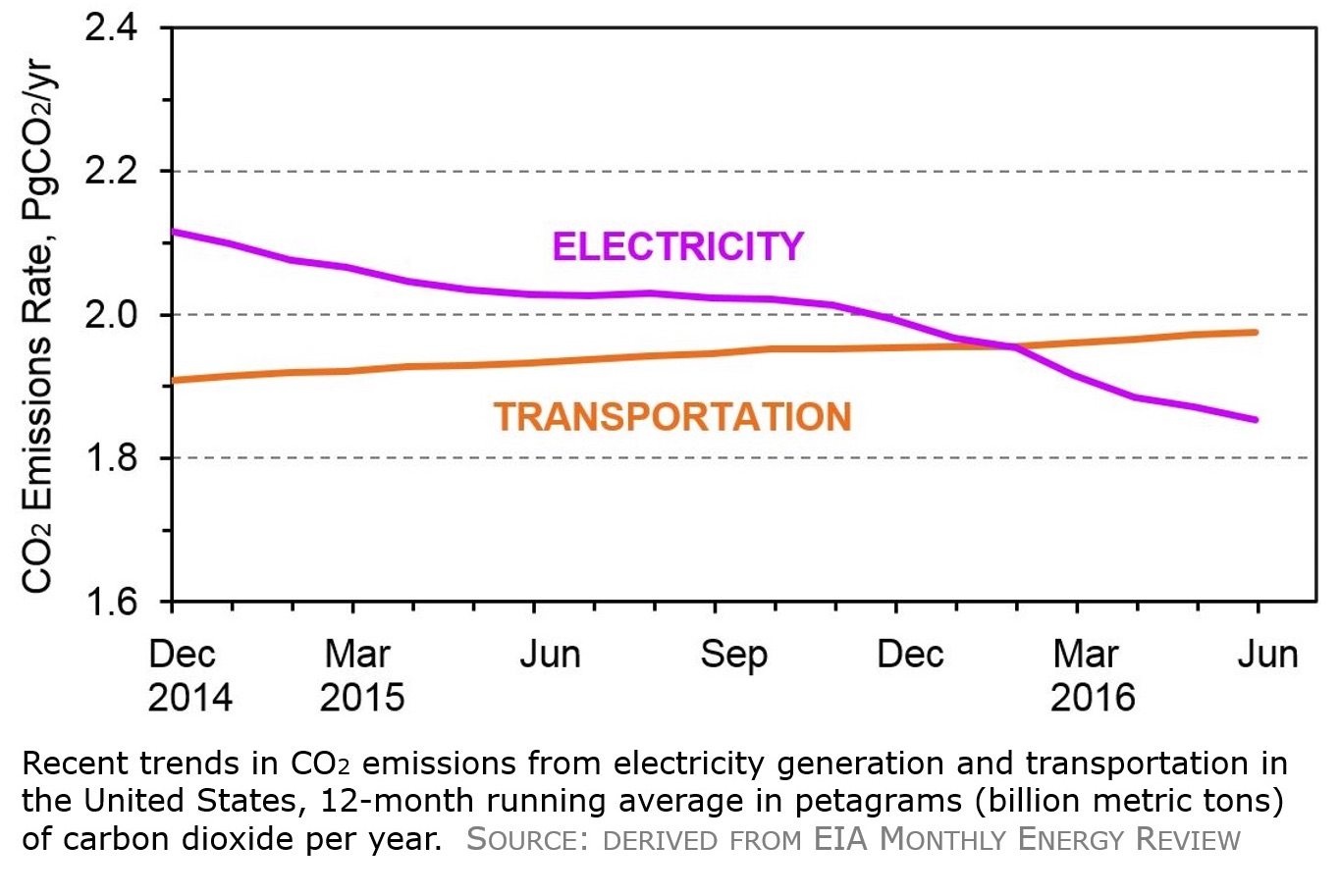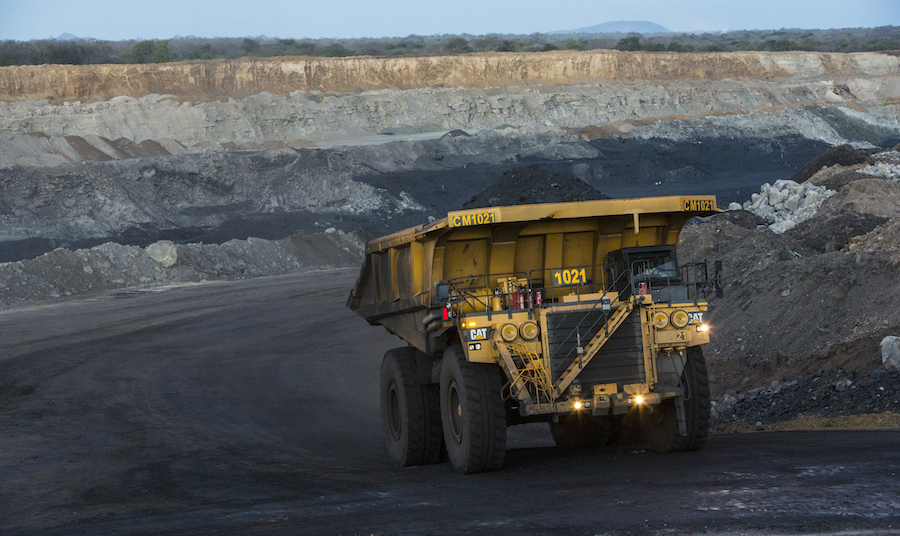Transportation about to pass power generation as biggest source of U.S. CO2 emissions

2016 may well go down as an “annus horribilis” for coal, particularly in the United States where big coal companies have gone bankrupt and miners have lost their jobs, fueling discontent in America’s coal heartland which is playing out, at least partially, in the polarized race for the White House in November.
But according to one university researcher, this year may be remembered for another reason: 2016 will likely be the year that C02 emissions from the transportation sector exceeded those of the power-generation sector – a large swath of the American economy that includes coal, natural gas, hydroelectric power and renewable energy.
According to an analysis done by John DeCicco, a research professor at the University of Michigan Energy Institute, for seven out of the past eight months, transportation has been a greater source of carbon dioxide emissions than electrical power generation. If the trend continues, 2016 will be the first year in nearly four decades when CO2 emissions from cars, trucks, buses and airplanes exceeded pollution from coal and natural-gas electricity generation, DeCicco writes in his Cars & Climate blog.
 DeCicco says emissions from the two sectors were essentially tied in the late 1970s, but more fuel-efficient vehicles introduced after the 1973 Saudi oil embargo and the 1979 Iranian revolution curtailed fuel demand and CO2 emissions for the next two decades. “Meanwhile, electricity use continued to grow and until recently relied mainly on coal as its source of energy,” says DeCicco, who goes on to explain how CO2 levels from electricity generation versus transportation began moving in opposite directions.
DeCicco says emissions from the two sectors were essentially tied in the late 1970s, but more fuel-efficient vehicles introduced after the 1973 Saudi oil embargo and the 1979 Iranian revolution curtailed fuel demand and CO2 emissions for the next two decades. “Meanwhile, electricity use continued to grow and until recently relied mainly on coal as its source of energy,” says DeCicco, who goes on to explain how CO2 levels from electricity generation versus transportation began moving in opposite directions.
Since reaching a peak in 2007, electric sector emissions have fallen at an average annual rate of 2.8 percent through last year. Although the recession dampened power demand, the big story was the rejuvenation of domestic natural gas production due to fracking. Combined with progress in wind and solar power and ongoing energy efficiency gains, the result was a 20% drop in U.S. electric sector CO2 emissions over the past eight years, from 2.5 billion metric tons per year in 2007 to 2.0 billion tons per year in 2015.
CO2 emissions from transportation also fell during the recession. Moreover, auto efficiency was by then rising again due to higher pump prices and stronger Corporate Average Fuel Economy (CAFE) standards soon amplified by new motor vehicle greenhouse gas (GHG) emissions standards. However, the decline in transportation sector CO2 emissions was short lived. Starting in 2012, economic recovery and a moderation of motor fuel prices have turned the sector’s CO2 emissions upward. The rate at which carbon is emitted from mobile sources rose at an average rate of 1.8 percent per year over the past four years. Calendar year 2015 saw transportation and electricity generation in a statistical tie as sources of CO2.
Anyone who has been stuck in gridlock on a U.S. highway would no doubt agree with DeCicco’s analysis, which is based on monthly stats from the Energy Information Administration (EIA). According to the Federal Highway Administration, U.S. motorists drove 3.1 trillion miles in 2015, an all-time record.
More News
{{ commodity.name }}
{{ post.title }}
{{ post.date }}



Comments
J. D. Baker
As the detailed technical brief readily confirms, for power generation the shift away from coal enabled CO2 emissions to fall even though there was little net change in how much electricity the nation consumed.
Specifically, from 2007 to 2015 U.S. electricity consumption fell just 0.7%, but the sector’s CO2 emissions dropped 20%. Moreover, during this time window the share of electricity generated by coal fell from 50% to 34% – which is the driving primary contributor.
Drilling down into hard data we find this huge coal displacement was realized by increased reliance on following:
1. Natural Gas rose from 20% to 32%,
2. Wind from 0.9% to 4.9%, and
3. Solar from 0.02% to 0.66%
Importantly, the nuclear portion of power production (keeping in mind nuclear power has no byproduct CO2 generation) held steady at around 20%. If limiting CO2 was the actual primary objective here, then natural gas and nuclear are critical focus for baseload generation.
Thus, the drop in electric sector CO2 emissions from 2.5 PgCO2/yr in 2007 to 2.0 PgCO2/yr in 2015 averages out to a 2.8% per year rate of decline.
Note: Pg = Peta grams (i.e., 10^15 grams)
In summary, credit for power generation fuel related CO2 decrease is primarily due to fracking driving rapid displacement of coal by economical, cleaner domestic natural gas. Wind and solar remain minor players as confirmed by the data; US power production will continue to be driven largely by natural gas, nuclear and coal.
Also, keep in mind the inconvenient truth that RFS and biofuels are contributing to transportation byproduct CO2. Yet politicians, greens and other special interests continue to avoid taking action for this low hanging fruit.